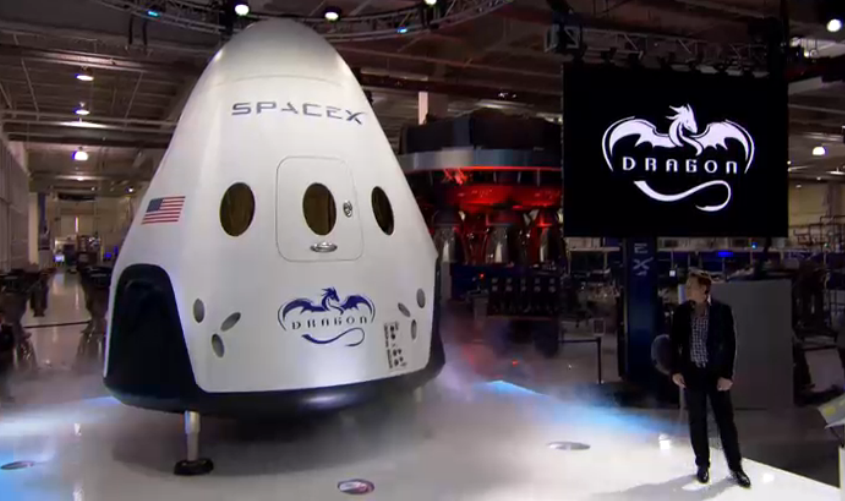I’m now officially two weeks late in commenting on this topic, but that’s apparently going to be the new reality around this blog, so let’s just pretend for a minute that it’s two weeks ago, okay?
So, did y’all watch the big unveiling of the SpaceX Dragon V2 spacecraft that I pinged you about? Yeah, I didn’t either. I was getting ready to go camping that evening. If you’re interested, you can see a recording of the event here; if nothing else, it’s kind of entertaining to watch Elon Musk doing a giggly, somewhat awkward impression of Robert Downey Jr.’s Tony Stark from the Iron Man movies (i.e., gazillionaire boy wonder making a slick pitch for some new technological marvel). But hey, you’re probably too impatient for the video, so let’s cut to the chase. Here’s the new ship, with Musk standing to the right:
 My first impression is, well, that kinda cool. But while a lot of other space bloggers have been gushing about how cool and futuristic it looks, I find there’s something… ungainly about its shape, at least to my eye. Still, if it works as Musk says it will, its appearance will be pretty irrelevant, and its function may well turn out to be revolutionary.
My first impression is, well, that kinda cool. But while a lot of other space bloggers have been gushing about how cool and futuristic it looks, I find there’s something… ungainly about its shape, at least to my eye. Still, if it works as Musk says it will, its appearance will be pretty irrelevant, and its function may well turn out to be revolutionary.
The vehicle is obviously derived from the cargo-only version that’s been delivering groceries to the International Space Station for a couple years now; the big difference I immediately noticed is that the V2 has three large windows instead of the single, hatch-mounted porthole of its predecessor, a dead giveaway that this machine is built to carry human beings who might want to see what’s outside. The V2 also has a sleeker hull, without as many exposed seams or technical systems as the version-1 Dragon. And of course, there are those stubby little landing legs.
Yes, the rumors are true. Instead of splashing down in the ocean like every other U.S. spacecraft to date except the winged space shuttles, the V2 is designed to land on terra firma, descending on rocket thrusters and touching down “with the accuracy of a helicopter,” according to Musk. (There will be parachutes in case the thruster system fails.) The video I linked a moment ago includes a brief animation at about the 4:00-minute mark, showing how this is supposed to work.
Another interesting innovation that stands out (especially after watching the animation) is the retractable nose cone that conceals an extendible docking ring. I’m not sure any previous spacecraft has had such a system, unless you count (again) the shuttles, which carried a docking rig in their payload bays once the ISS was under construction. And in an interesting bit of corporate synergy, the Dragon V2 will be controlled with the very same digital touchscreen technology used in the Tesla Model S electric cars built by Musk’s other technology venture. I’m not too keen on those, to be honest; touchscreens and I don’t get along. Think about that old Simpsons episode where Bart sells his soul for five bucks, and then finds that automatic doors will no longer open for him. That’s me and pretty much any smartphone or tablet I’ve ever played with. I much prefer the satisfyingly solid snap of a good old-fashioned toggle switch or push button. But then, how could I not? Like the tagline says, I’m an analog kind of guy.
Mild reservations about the styling aside, the Dragon V2 looks pretty impressive, and I’m looking forward to seeing it actually fly and, more exciting, land. Musk’s goal is for this vehicle to achieve what my beloved shuttles never quite pulled off: quick, simple and, most of all, relatively inexpensive reusability. Let’s hope the V2 meets the goal.
The Dragon V2 is not technically “human rated” yet — it still needs to jump through certain hoops for NASA to meet that definition — and its first test flight may come as early as next year. NASA wants a commercial spacecraft ready to carry astronauts by 2017, and although I know a couple other companies are working to meet that deadline with their respective vehicles, SpaceX will likely get there first.
If you’re interested in further reading, the Bad Astronomer Phil Plait has a few thoughts here, and Ars Technica had some good technical (but not too technical!) detail in their article.
Photo source: SpaceX official Twitter feed

